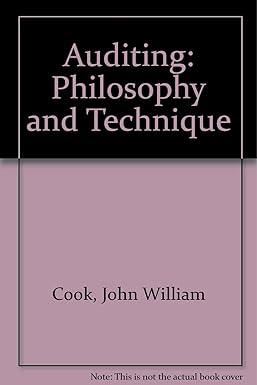Question
Question On December 31, 2020, before the books were closed, management and the accountant at Flanagan Inc. made the following determinations about three depreciable assets.
Question
On December 31, 2020, before the books were closed, management and the accountant at Flanagan Inc. made the following determinations about three depreciable assets.
- Depreciable asset A (building) was purchased on January 2, 2017. It originally cost $540,000 and the straight-line method was chosen for depreciation. The asset was originally expected to be useful for 10 years and have no residual value. In 2020, the decision was made to change the depreciation method from straight-line to double-declining-balance due to a change in the pattern of benefits received. The estimates relating to useful life and residual value remained unchanged.
- Depreciable asset B (machinery) was purchased on January 3, 2016. It originally cost $180,000 and the straight-line method was chosen for depreciation. The asset was expected to be useful for 15 years and have no residual value. In 2020, the decision was made to shorten this asset's total life to nine years and to estimate the residual value at $3,000.
- Depreciable asset C (equipment) was purchased on January 5, 2016. The asset's original cost was $160,000 and this amount was entirely expensed in 2016 in error. This particular asset has a 10-year useful life and no residual value. The straight-line method is appropriate.
The accountant mentioned that the corporation was experiencing a higher than expected number of bad debt write offs in the current year. For this reason, the bad debts percentage of accounts receivable used in the year-end adjustment was changed from 6.5% to 8%. The bad debt expense for the current year was calculated using the new rate of 8%. The controller estimates that, if the new rate had been used in the past, an additional $15,000 worth of bad debts would have been recorded.
Additional information:
- Income in 2020 before depreciation expense amounted to $400,000.
- Depreciation expense on assets other than A, B, and C totalled $55,000 in 2020.
- Income in 2019 was reported at $370,000.
- In both 2019 and 2020, 100,000 common shares were outstanding. No dividends were declared in either year.
- Flanagan Inc. follows IFRS.
- The companys tax rate is 40% for all relevant years.
Required 1: Prepare any necessary entries in 2020. Round the rate of depreciation under the double-declining-balance method to one decimal place.
Required 2: Calculate the adjusted net income and earnings per share for 2019 and 2020. Round earnings per share to the nearest cent.
Required 3: Prepare comparative retained earnings statements for Flanagan Inc. for 2019 and 2020. The company reported retained earnings of $200,000 at December 31, 2018.
Required 4: Prepare the required note disclosures for each of these changes.
Step by Step Solution
There are 3 Steps involved in it
Step: 1

Get Instant Access to Expert-Tailored Solutions
See step-by-step solutions with expert insights and AI powered tools for academic success
Step: 2

Step: 3

Ace Your Homework with AI
Get the answers you need in no time with our AI-driven, step-by-step assistance
Get Started


